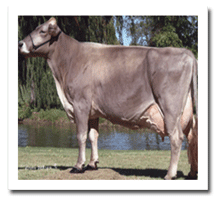Exotic dairy breeds of cattle
1. Jersey

- It is the smallest of the dairy types of cattle developed on island of Jersey, U.K.
- In India this breed has acclimatized well and is widely used in cross breeding with indigenous cows.
- The typical colour of Jersey cattle is reddish fawn.
- Dished fore head and compact and angular body.
- These are economical producers of milk with 5.3% fat and 15% SNF.
2. Holstein Friesian

- This breed was developed in the northern parts of Netherlands, especially in the province of Friesland.
- They are ruggedly built and they possess large udder.
- They are the largest dairy breed and mature cows weigh as much as 700kg.
- They have typical marking of black and white that make them easily distinguishable.
- The average production of cow is 6000 to 7000 kgs per lactation. However, the fat content in their milk is rather low (3.45 per cent).
3. Brown Swiss

- The mountainous region of Switzerland is the place of origin of Brown Swiss breed.
- It is famous in its home tract for its rugged nature and good milk production.
- The Karan Swiss is the excellent crossbred cattle obtained by crossing this breed with recognized Indian breeds of cattle.
4. Red Dane

- The typical body colour of this Danish breed is red, reddish brown or even dark brown.
- It is also a heavy breed; mature males weighing up to 950 kgs and mature female weigh 600 kgs.
- The lactation yield of Red Dane cattle varies from 3000 to 4000 kgs with a fat content of 4 per cent and above.
5. Ayrshire

- Origin Ayrshire in Scotland is considered as most beautiful dairy breed. These are very active animals but hard to manage.
- They do not produce as much milk or butter fat (only 4%) as some of the other dairy breeds.
- The breed was also known as Dunlop cattle or Cunningham cattle.
6. Guernsey

- Originated from Small island of Guernsey (France).
- The milk has a golden colour due to an exceptionally high content of beta carotene which may help to reduce the risks of certain cancers.
- The milk also has a high butterfat content of 5% and a high protein content of 3.7%.
- Guernsey cows produce around 6000 litres per cow per annum.
- The Guernsey cow has many notable advantages for the dairy farmer over other breeds includes high efficiency of milk production, low incidence of calving difficulty and longevity.
Comments
Post a Comment